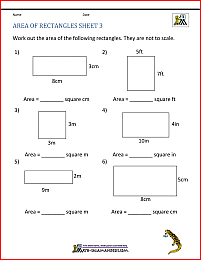
This is possible because area is additive. One can “find areas of rectilinear figures by decomposing them into non-overlapping rectangles and adding the areas of the non-overlapping parts” (CCSS, standard 3.MD.7d).Students “learn to understand and explain that the area of a rectangular region of, for example, 12 length-units by 5 length-units can be found either by multiplying $$12\times5$$, or by adding two products, e.g., $$10\times5$$ and $$2\times5$$, illustrating the distributive property” ( Progressions for the Common Core State Standards in Mathematics, K-5, Geometric Measurement, p.Students “learn to rotate rectangular arrays physically and mentally, understanding that their areas are preserved under rotation, and thus, for example, $$4 \times 7 = 7 \times 4$$, illustrating the commutative property of multiplication” ( Progressions for the Common Core State Standards in Mathematics, K-5, Geometric Measurement, p.One can find the area of a rectangle by counting individual square units or by multiplying the length and width of the figure.Area refers to the amount of space a two-dimensional figure takes up.Pacing: 16 instructional days (14 lessons, 2 flex days, 1 assessment day)

Students will also use this understanding outside of their study of geometry, as multi-digit multiplication problems in Grade 4 (4.NBT.5), fraction multiplication in Grade 5 (5.NF.4), and even polynomial multiplication problems in Algebra (A.APR.1) rely on an area model. Then, in future grades, students will rely on the understanding of area to solve increasingly complex problems involving area, perimeter, surface area, and volume (4.MD.3, 5.MD.3-5, 6.G.1-4). In Unit 5, students will study perimeter and distinguish between the measures of area and perimeter. Further, students make use of physical tiles, rulers to relate side lengths to physical tiles, and later in the unit, the properties of operations themselves in order to find the area of a rectangle (MP.5). Additionally, “to build from spatial structuring to understanding the number of area-units as the product of number of units in a row and number of rows, students might draw rectangular arrays of squares and learn to determine the number of squares in each row with increasingly sophisticated strategies, such as skip-counting the number in each row and eventually multiplying the number in each row by the number of rows (MP.8)” (GM Progression, p. Such reasoning processes amount to brief arguments that students may construct and critique (MP.3)” (PARCC Model Content Frameworks for Mathetmatics, p. This is an example of seeing and making use of structure (MP.7). For example, students “use strategies for finding products and quotients that are based on the properties of operations for example, to find $$4\times 7$$, they may recognize that $$7 = 5 + 2$$ and compute $$4 \times 5 + 4 \times 2$$. Students will engage with many mathematical practices deeply in the unit. Thus, the unit serves as a way to link topics and thinking across units, providing coherence between the work with multiplication and division in Units 2 and 3 (3.OA) with the work of area in this unit (3.MD.C). Lastly, students connect the measure of area to both multiplication and addition, seeing with concrete cases that the area of a rectangle with whole-number side lengths $$a$$ and $$b + c$$ is the sum of $$a\times b$$ and $$a\times c$$ (3.MD.7c), and using the more general idea that area is additive to find the area of composite figures (3.MD.7d). After extensive work to develop students’ spatial structuring, students connect area to the operation of multiplication of length and width of the figure (3.MD.7a, b). In Grade 2, students, partitioned a rectangle into rows and columns of same-sized squares and counted to find the total number of them, including using skip-counting and repeated addition to more efficiently do so (2.G.2, 2.OA.4).Īt the beginning of this unit, students develop an understanding of area as an attribute of plane figures (3.MD.5) and measure it by counting unit squares (3.MD.6). In early elementary grades, students may have informally compared area, seeing which of two figures takes up more space. In Unit 4, students understand area as how much two-dimensional space a figure takes up and relate it to their work with multiplication and division in Units 2 and 3.


 0 kommentar(er)
0 kommentar(er)
